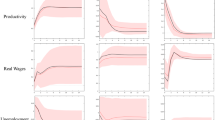Abstract
A flow model of labor market participation is used to describe how various exogenous variations jointly affect unemployment and participation and provides short-run identification restrictions of a structural VAR. In some countries, fast rising female participation may have had a moderate short- and medium-run impact on unemployment rates. A variance decomposition exercise indicates that, in Continental Europe, participation is driven in the short run by unemployment shocks, whereas in the USA, it is driven by participation shocks (demography, immigration). Unemployment in Europe is driven by participation shocks, whereas in the USA, it is driven by unemployment shocks.
Similar content being viewed by others
References
Acemoglu D (1999) Changes in unemployment and wage inequality: an alternative theory and some evidence. Am Econ Rev 89(5):1259–1278
Algan Y, Cahuc P (2004) Job Protection: The Macho Hypothesis IZA DP 1192
Auer P, Cazes S (2000) Stable or unstable jobs: untangling and interpreting the evidence in Industrialized Countries ILO discussion paper
Berger MC (1983) Changes in labor force composition and male earnings: a production approach. J Hum Resour 18(2):177–196
Blanchard OJ, Perotti R (2002) An empirical characterization of the dynamic effects of changes in government spending and taxes on output. Q J Econ 117(4):1329–1368
Blanchard OJ, Quah D (1989) The dynamic effects of aggregate demand and supply disturbances. Am Econ Rev 79(4):655–673
Blanchard OJ, Wolfers J (2000) The role of shocks and institutions in the rise of european unemployment: the aggregate evidence. Econ J 110: C1–C33
Boeri T, Garibaldi P (2002) Shadow Activity and Unemployment in a Depressed Labor Market CEPR DP 3433
Boeri T, Garibaldi P (2005) Shadow Sorting NBER Macroeconomic Annual–ISOM Conference
Cahuc P, Marque F, Wasmer E (2004) Intrafirm wage bargaining in matching models: macroeconomic implications and resolution methods with multiple labor inputs CEPR DP 4605
Cole HL, Rogerson R (1999) Can the Mortensen–Pissarides matching model match the business-cycle facts? Int Econ Rev 40(4): 933–959
Flinn CJ, Heckman, JJ (1983) Are unemployment and out of the labor force behaviorally distinct labor force states? J Labor Econ 1(1):28–42
Galí J (1999) Technology, employment and the business cycle: do technology shocks explain aggregate fluctuations? Am Econ Rev 89(1):249–271
Garibaldi P, Wasmer E (2005) Labor market flows and equilibrium search unemployment. J Eur Econ Assoc 3(4):851–882
Garibaldi P, Wasmer E (2003) Equilibrium search unemployment, endogenous participation and labour market flows. CEPR DP 3986
Genre V, Gomez-Salavador R, Lamo A (2003) European women: why do(n’t) they work? paper presented at the ECB–CEPR labor workshop, June
Grant JH, Hamermesh DS (1982) Labor market competition among youths white women and others. Rev Econ Stat 63(3):354–360
Hamermesh DS (1986) The demand for labor in the long run. In: Ashenfelter O, Layard R (eds) Handbook of labor economics, vol I. Elsevier
Hamermesh DS, Grant J (1979) Econometric studies of labor–labor substitution and their implications for policy. J Hum Resour 14(4):518–542
Jaumotte F (2003) Female labour force participation: past trends and main determinants in OECD countries ECO/WKP(2003)30, OCDE
Jones SRG, Ridell WC (1999) The measurement of unemployment: an empirical approach. Econometrica 67(1):147–162
Juhn C, Kim D II (1999) The effects of rising female labor supply on male wages. J Labor Econ 17(1):23–48
Mortensen DT, Pissarides CA (1994) Job creation and job destruction in the theory of unemployment. Rev Econ Stud 64:397–415
Nickell S, Nunziata L, Ochel W (2005) Unemployment in the OECD since the 1960s. What do we know? Econ J 115(500):1–27
Nunziata L (2003) Labour market institutions and the cyclical dynamics of employment. Labour Econ 10(1):31–53
Pissarides CA, Garibaldi P, Olivetti C, Petrongolo B, Wasmer E (2005) Women in the labor force: how well is Europe doing?. In: Boeri T, del Boca D, Pissarides C (eds) Women at work. An economic perspective. Oxford University Press, pp 7–95
Phillips PC (1998) Impulse response and forecast error variance asymptotics in nonstationary VAR’s. J Econometrics 83(2):21–56
Sims, CA, Stock JH, Watson M (1990) Inference in linear time series models with some unit roots. Econometrica 58(1):113–44
Stole LA, Zwiebel J (1996) Organizational design and technology choice under intrafirm bargaining. Am Econ Rev 86(1):195–222
Topel RH (1994a) Wage inequality and regional labour market performance in the US. In: Tachibanaki T (ed) Savings and bequests. Ann Arbors University Michigan Press
Topel RH (1994b) Regional labor markets and the determinants of wage inequality. Am Econ Rev Pap Proc 84(2):17–22
Topel RH (1997) Factors proportions and relative wages: the supply-side determinants of wage inequality. J Econ Perpsect 11:55–74
Wasmer E (1997) Changes in the composition of labour supply. Implications for wages and unemployment Phd dissertation. Departement of Economics, London School of Economics
Author information
Authors and Affiliations
Corresponding author
Additional information
Responsible editor: Deborah Cobb-Clark
Rights and permissions
About this article
Cite this article
Wasmer, E. Links between labor supply and unemployment: theory and empirics. J Popul Econ 22, 773–802 (2009). https://doi.org/10.1007/s00148-007-0161-8
Received:
Accepted:
Published:
Issue Date:
DOI: https://doi.org/10.1007/s00148-007-0161-8




